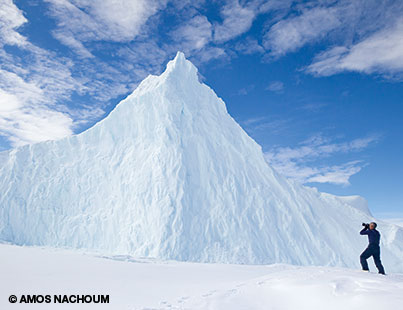
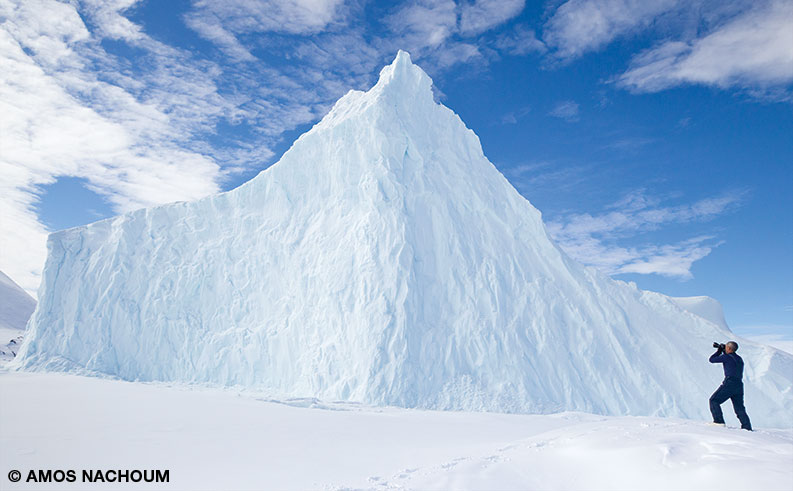
It amuses me to imagine that the ancient Greeks knew polar bears lived at one of the poles but not the other. They named the North Pole Arktikos (from arktos, for "bear") and the South Pole Antarktikos ("ant-" meaning against or opposite, as in no polar bears). Yet more than polar bears, or the absence thereof, defines the northern and southern extremes of our planet.
My anticipation builds mightily as I make my way to Baffin Island in the Canadian High Arctic. As far as my eyes can see from our 38,000-foot altitude, the horizon is sparkling white and very bright, making the airplane cabin uncomfortably warm for the three-hour trip to Pond Inlet. It is June and midsummer there, the time of year when the sun never sets but shines 24 hours a day. The light quality changes as the day progresses, as clouds, moisture and winds come and go, yet darkness never descends.
As the light shifts during the day, so do the wildlife activities
Like in the African savannah, the predators rest at midday when the sun is brightest. As the light becomes warmer and more textured in the afternoon, the fresh footprints of a polar bear can be seen. Our elder Inuit guide stops our caravan of snowmobiles to review the fresh markings on the ice sheet, then quietly mounts his vehicle and leads us away. Even with the sun blazing overhead, the temperature is below freezing, though we don't feel it. We are well insulated by the extra-warm Canadian parkas furnished by the tour operator, and of course, the excitement of our destination keeps our mind off the cold and on the anticipated encounter. Even bone-chilling blasts of cold arctic air do nothing to dampen our spirits.

With the help of our Inuit guides, we set up camp when we reach the water. Each of us has an individual, single-occupancy tent pitched by the floe's edge only 50 yards from the sea, affording a primordial and spectacular view. We face the water of Lancaster Sound and strain our eyes to glimpse the arrival of the most mystical presence in the High Arctic, the narwhal whale.
Night after night, we remain awake between midnight and 5 a.m., standing only a few feet from the floe's edge, our tripods extended, cameras and long lenses (300mm to 600mm) mounted. The ice under our feet is 10 feet thick, but beneath that is 800 feet of water. The light is an extraordinarily cool blue as we wait for the narwhals' arrival. Every so often one of us runs to the kitchen tent, bringing hot tea or coffee to the others to help keep us awake during our silent vigil.
Then, just before 2 a.m., the first narwhal of the season arrives. It is male, easily identified by his tusk (which is actually an extended tooth). We are ecstatic, and we race to our cameras. The atmosphere is eerily calm, and the water is like glass. The sun still shines, but it is low, painting the water and ice with light that looks like blue and pink satin.

The silence is broken as we hear the exhalation of the narwhal. The sound carries deceptively far in the still air. He is still a distance away, yet we stand poised, cameras pointing, shouting directions of possible sightings. Finally we see it: a burst of spray in the air 50 yards away. The smooth bump of a narwhal's head breaks the surface, a telltale wave rolling before the emerging spear. The calm of the clear, cold morning disappears in the rapid cacophony of our motor drives. The noise is reminiscent of a machine gun, yet it lasts only a brief two seconds before there is silence once again. Giggling begins to fill the air. We have scored the first images of our trip, and high fives and laughter relieve the tension of the night. That's how it goes on photographic expeditions, though: long waits and sheer boredom punctuated by moments of extraordinary excitement.
On days when topside action eludes us, or when weather closes in on us to preclude any hope of taking photos, we go diving under the ice. Diving under arctic ice is like diving in freshwater cenotes, the ice reminiscent of stalactites, the colors various shades of vibrant blue. To execute the dive, we look for a cut or a break in the ice, following it from the floe's edge to the end of the cut. When the crack is big enough, two divers at a time are attached to the surface with a line monitored by a surface tender.
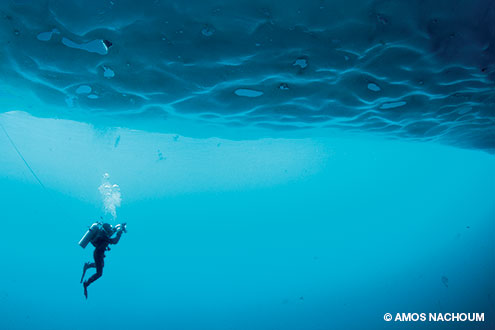
The marquee High Arctic dive is with the narwhals. Each year the whales migrate to the area to enter the inlet, where the Arctic char congregate. But the whales need an entry route that allows access to the surface (they need to breathe), so they come in June when the ice breaks up enough to allow them to work their way into the inlet. Even then it's tricky for them; there is considerable trial-and-error as they seek their way. If we're lucky, we'll photograph them as they search for access cuts through the ice. To see us well, the narwhal will turn on its back and look at us, giving us the prevailing belly-toward-diver perspective.
The arrival of the narwhal in the area also coincides with the arrival of the Inuit hunters. Hunting is an Inuit tradition, but the elders understand the ramifications of their actions. Limits are set, hunters are trained, and strict observation by the elders instills discipline.
The whale carcass emits a scent that attracts the polar bears. It's 3 a.m. on the last night of our High Arctic adventure, and the night is clear; no clouds filter the low, deep-yellow sun. When the bears amble along the floe's edge, they are lit as if in spotlights on stage; the rich light bounces off their fur in a vibrant quality only Mother Nature can create. The bears amble closer to the camp, and every photographer in the group retrieves his tripod, pulls the heavy lenses and begins to walk closer.
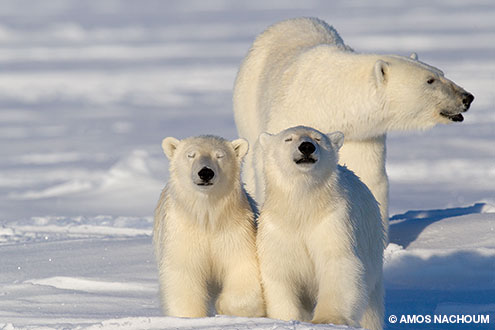
The snow is deep, and we fall facedown, with our cameras, into the soft drift. Creeping one step at a time, lifting the heavy lenses away from the ice, we struggle to get close to the bears. The female's sense of smell detects us amidst the carcass scent. She pauses, closes her eyes and raises her dark, pointy nose in our direction. Her two young cubs move closer toward our line of cameras.
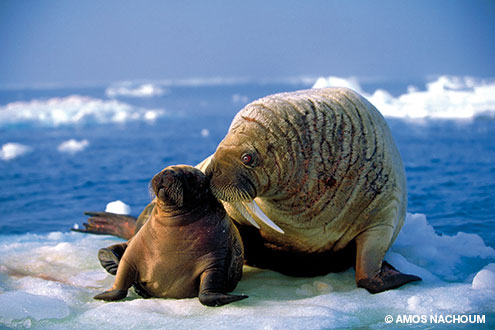
One of the brazen youngsters stands up on his rear legs and waves his arms at us; his sibling is shy and stays close to his mother, waiting for her signal on what to do next. She detects more movement from us and leads her boys out of reach of our commotion. But suddenly, she changes her mind and turns back toward us. We have one last splendid photo opportunity, all the more significant because we had to wait until the bitter end to be able to capture the moment.
The High Arctic and Antarctica are radically different.
It is possible to reach Antarctica only by ship. While a three-hour flight will get you to the High Arctic, it takes two to three days from Ushuaia, Argentina, to reach the Antarctic Peninsula.
To get there, we cross what some regard as the world's roughest seas. I've done the crossing two dozen times, and my experience is that crossing the South Atlantic is difficult only about 20 percent of the time. However, when it is rough, it is very, very rough. In fact, it's scary rough, but the crews who travel the waters are experienced and our ship is up to the challenge.
In contrast to camping in the High Arctic, all recreational visitors to Antarctica reside aboard their vessel. There are no land-based accommodations, and overnight stays are generally not permitted on Antarctica soil, mainly to protect the land from human impact.
There are no polar bears in the South Pole, so the leopard seal fills the role of apex predator in Antarctica. Though primarily a marine mammal, it takes its prey, the penguins, from the shoreline. Orcas also patrol here, but the leopard seal remains the unique and iconic photographic subject of this environment.
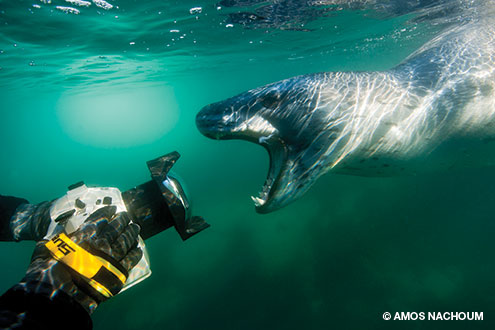
The leopard seal belongs to the Pinnipeda superfamily. These seals can reach up to 12 feet in length and weigh more than 1,000 pounds. During the summer they feed on young penguins; the remainder of the year finds them in the deep ocean feeding on krill.
Due to the expanding scientific and recreational travel to Antarctica, more is being learned of leopard seals beyond previous surface observation. Their large size, powerful jaws, fearsome canine teeth and underwater agility give them a fierce reputation. In my experience, though, they are very curious of divers in the water. They will come and play right in front of your face, overtly displaying their power for the camera. There are stories of domes badly scratched by leopard seals, but I have yet to have an encounter where either camera or diver are hurt. That's not to say it can't happen. It can and has, but it's exceedingly rare.
The hunting and feeding actions by the leopard seal are fascinating. They can be spotted swimming along the icebergs, close to penguin colonies. When the tide is low, young penguins jump into the water. The seal waits in shallow water with its head submerged, perfectly camouflaged as a rock. As is their habit, the naïve penguins play around the rock. When enough penguins surround the seal, it lunges at one of its surprised victims. Holding it in its powerful teeth, the seal swims from the rocky shallows into deep water, where it remains until the penguin drowns. Sometimes a penguin is able to break free from the seal and swim to shore in a futile attempt to escape its predator. In a magnificent display of power, the seal will follow, climbing over rocks and ice to pursue the wounded penguin and drag it back into the water.
There are three species of penguins easily seen along the Antarctica peninsula: gentoo, chinstrap and Adélie penguins. The best time to see them is December through March, though February and March are optimal. The sea ice is mostly melted, and the young chicks are mature enough for the parents go to sea to hunt. The conditions are perfect for the leopard seal to ambush the playful, and unattended, young penguins.
Both diving and snorkeling in Antarctica are encouraged. With advancements in drysuit garments and improved undergarment technology, the exposure to cold water is minimized to acceptable levels. Divers can stay comfortably submerged despite water temperatures of 28º to 32ºF. Given that salt water freezes at temperatures below 28ºF, the protection is cold comfort, indeed.

There are only two or three dive expeditions led to Antarctica each year, as the sea is mostly covered by ice. Our quest for the leopard seal satisfied, we turned our attention to the action's backdrop. The sheer marine beauty of an iceberg is surreal. White walls extend from well above sea level to a depth of 60 to 80 feet beneath the sea. It looks like a solid block of ice with the face corrugated in waves.
When clear of ice, there are a few familiar bays that provide good diving locations. The seafloor is covered by kelp with short stems and very thick, long leaves. We find giant starfish, large nudibranch, colorful crustaceans and mollusks. Of course, we are always searching for elusive ice fish, most typically blenny-like creatures
Antarctica does not have native people, like the Inuit of the High Arctic. A colorful cultural history is absent. Yet Antarctica abounds with amazing tales of exploration. Intrepid explorers such as Capt. Roald Amundsen, Capt. Robert Scott and Sir Ernest Shackleton pitted themselves against the elements in an attempt to reveal Antarctica's secrets and make history. Visitors today will find a few huts remaining from the early 20th-century expeditions, and those structures are now joined by research stations operated by teams from the United States, United Kingdom, the Ukraine, Argentina and Chile.

The landscape along the peninsula is simply stunning: narrow channels and towering mountains that have been covered in ice for generations. Every cruise to Antarctica takes place amidst the endlessly rugged topography. At first glance, the Antarctic color palette seems monochromatic, but when touched by sunlight, colors explode into view. Shades of deep blue emanate from old ice, white radiates from new ice, emerald green shines from the giant glaciers, and black lava rock gleams from inside the ice.
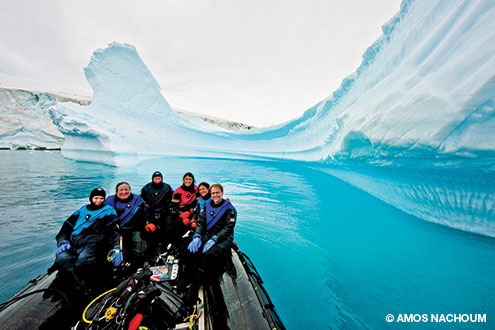
Gerlache Strait and Lemaire Channel are two of the most spectacular attractions. Imagine cruising down an icebound Grand Canyon. Granite mountains on both sides rise more than 4,500 feet above sea level. There is a sharp contrast of color between the black and brown of the exposed rocks and the ice accumulated through the millennium. The passage is narrow, and the floating icebergs slow the vessel's movement. Penguins race to the open sea, while humpback and minke whales frequent these passages on their way to find bays rich in plankton. The skipper announces sightings from the bridge, bringing everyone racing to the deck for yet another picture.
Sunrise and sunset are particularly spectacular over these water passages. The sunlight changes minute by minute, the reflections bouncing back from the endless expanse of icebergs and mountain slopes.
A visit to either pole is about experiencing life through epic moments impossible to experience anywhere else on Earth. Many travelers who visit the High Arctic inevitably follow the trip with a voyage to Antarctica. Life is short, and chances to live true adventures are rare. For those with a willing spirit and adequate resolve, a trip to either the North or South Pole is a trip of a lifetime. Given the chance, I will go to back again anytime.
MORE FROM
SAFE PASSAGE
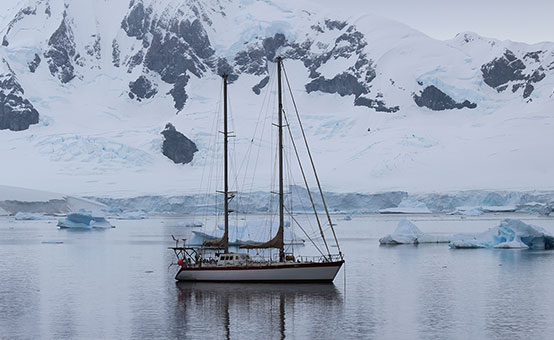
BOATING SAFETY | Dec 1, 2018
Cold Water Boating? It's Safer When You Do It Smarter

MEMBER STORIES | Oct 1, 2015
DAN to the Rescue: Out of Antarctica